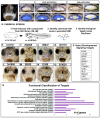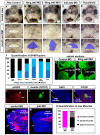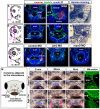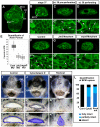Jak2 and Jaw Muscles Are Required for Buccopharyngeal Membrane Perforation during Mouth Development
- PMID: 37367478
- PMCID: PMC10298892
- DOI: 10.3390/jdb11020024
Jak2 and Jaw Muscles Are Required for Buccopharyngeal Membrane Perforation during Mouth Development
Abstract
The mouth is a central feature of our face, without which we could not eat, breathe, or communicate. A critical and early event in mouth formation is the creation of a "hole" which connects the digestive system and the external environment. This hole, which has also been called the primary or embryonic mouth in vertebrates, is initially covered by a 1-2 cell layer thick structure called the buccopharyngeal membrane. When the buccopharyngeal membrane does not rupture, it impairs early mouth functions and may also lead to further craniofacial malformations. Using a chemical screen in an animal model (Xenopus laevis) and genetic data from humans, we determined that Janus kinase 2 (Jak2) has a role in buccopharyngeal membrane rupture. We have determined that decreased Jak2 function, using antisense morpholinos or a pharmacological antagonist, caused a persistent buccopharyngeal membrane as well as the loss of jaw muscles. Surprisingly, we observed that the jaw muscle compartments were connected to the oral epithelium that is continuous with the buccopharyngeal membrane. Severing such connections resulted in buccopharyngeal membrane buckling and persistence. We also noted puncta accumulation of F-actin, an indicator of tension, in the buccopharyngeal membrane during perforation. Taken together, the data has led us to a hypothesis that muscles are required to exert tension across the buccopharyngeal membrane, and such tension is necessary for its perforation.
Keywords: Xenopus laevis; buccopharyngeal membrane; choanal atresia; mouth.
Conflict of interest statement
The authors declare no conflict of interest.
Figures







Similar articles
-
Role of JNK during buccopharyngeal membrane perforation, the last step of embryonic mouth formation.Dev Dyn. 2017 Feb;246(2):100-115. doi: 10.1002/dvdy.24470. Epub 2016 Dec 29. Dev Dyn. 2017. PMID: 28032936 Free PMC article.
-
Using frogs faces to dissect the mechanisms underlying human orofacial defects.Semin Cell Dev Biol. 2016 Mar;51:54-63. doi: 10.1016/j.semcdb.2016.01.016. Epub 2016 Jan 15. Semin Cell Dev Biol. 2016. PMID: 26778163 Free PMC article. Review.
-
Hedgehog activity controls opening of the primary mouth.Dev Biol. 2014 Dec 1;396(1):1-7. doi: 10.1016/j.ydbio.2014.09.029. Epub 2014 Oct 7. Dev Biol. 2014. PMID: 25300580 Free PMC article.
-
Development of the primary mouth in Xenopus laevis.Dev Biol. 2006 Jul 15;295(2):700-13. doi: 10.1016/j.ydbio.2006.03.054. Epub 2006 Apr 6. Dev Biol. 2006. PMID: 16678148
-
Mouth development.Wiley Interdiscip Rev Dev Biol. 2017 Sep;6(5):e275. doi: 10.1002/wdev.275. Epub 2017 May 17. Wiley Interdiscip Rev Dev Biol. 2017. PMID: 28514120 Free PMC article. Review.
Cited by
-
Dyrk1a is required for craniofacial development in Xenopus laevis.Dev Biol. 2024 Jul;511:63-75. doi: 10.1016/j.ydbio.2024.04.004. Epub 2024 Apr 15. Dev Biol. 2024. PMID: 38621649 Free PMC article.
References
Grants and funding
LinkOut - more resources
Full Text Sources
Miscellaneous

